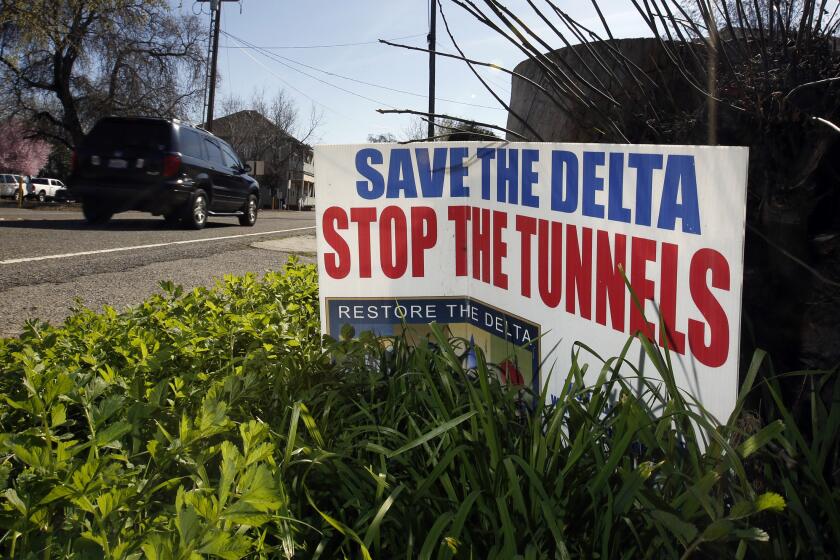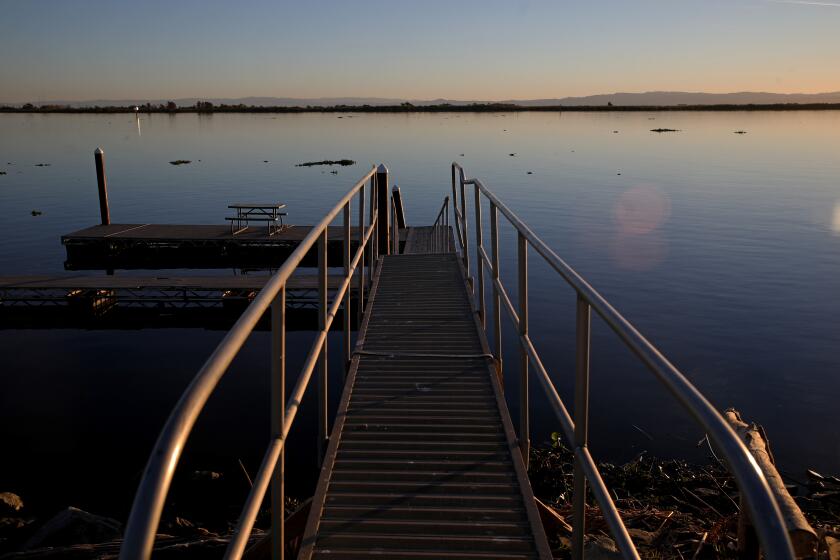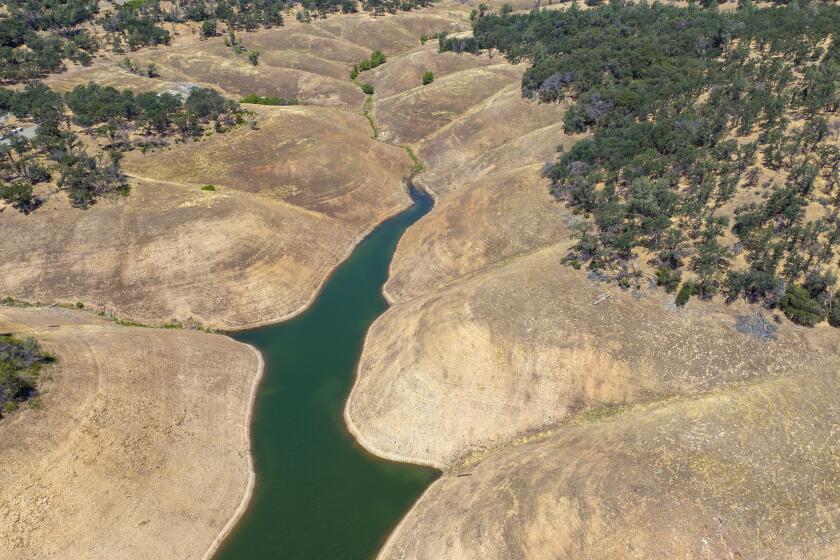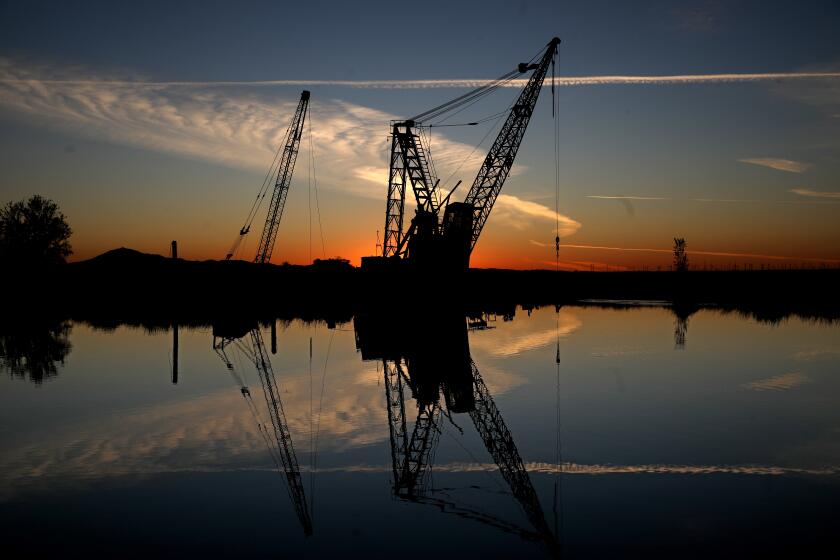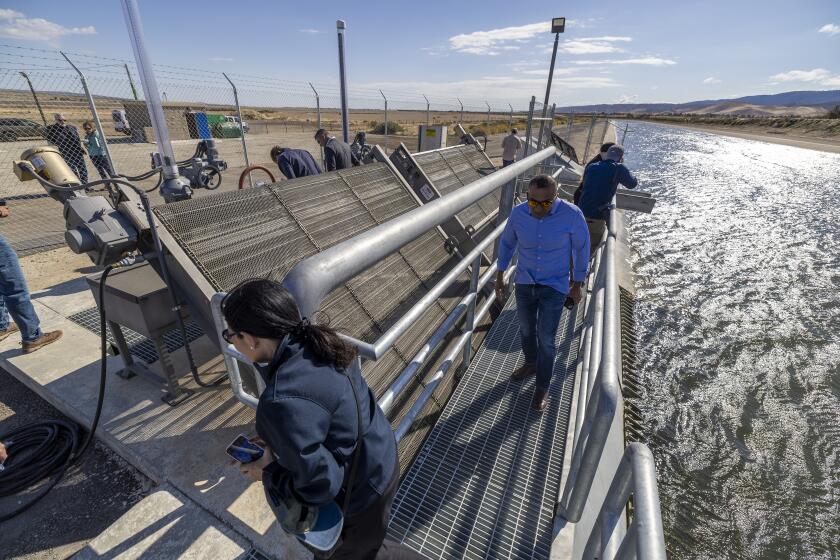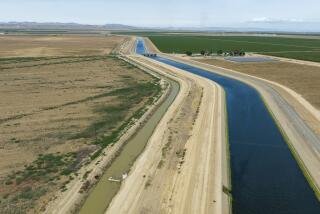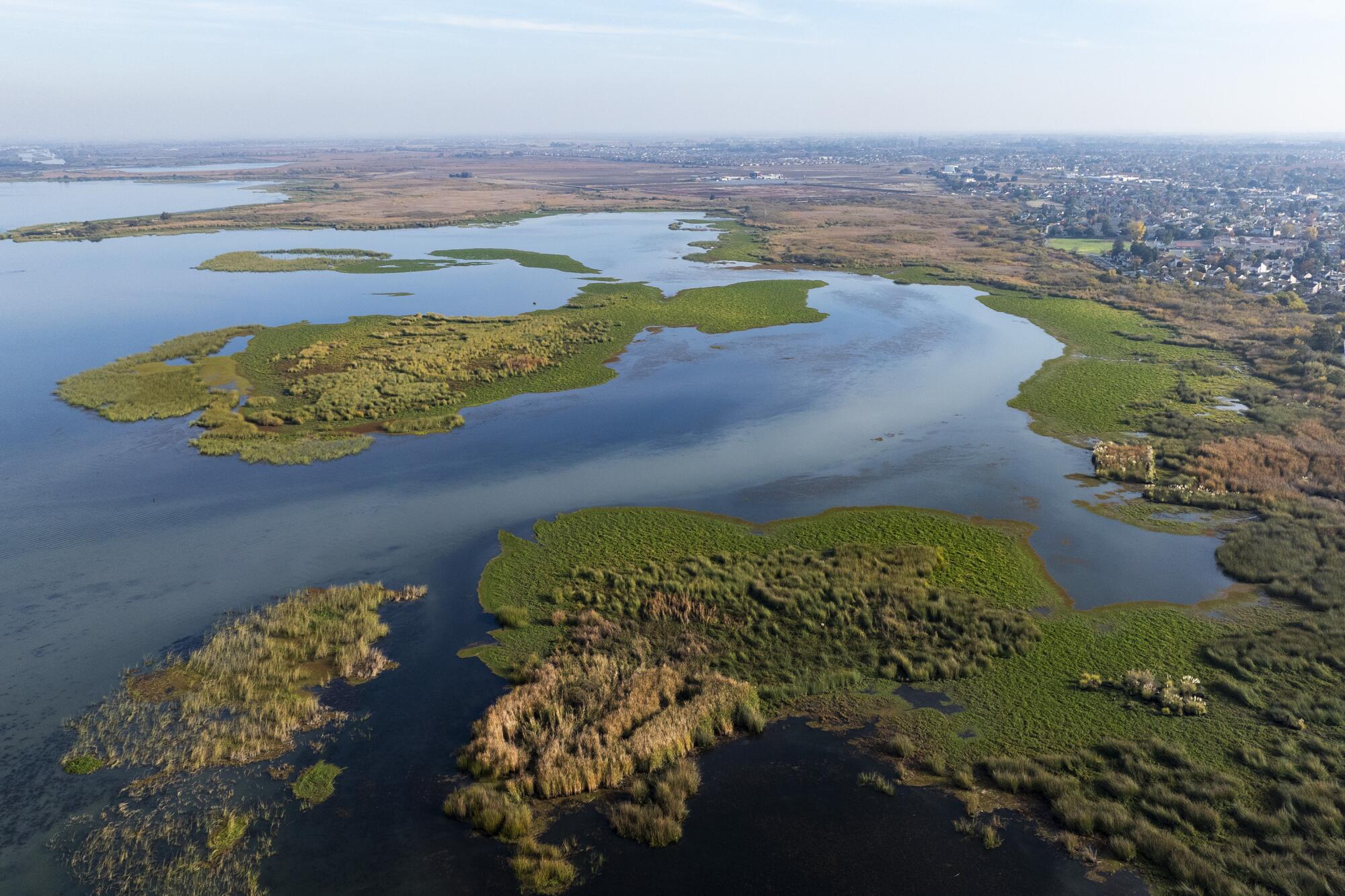
- Share via
HOOD, Calif. — In the heart of California, at the place where two great rivers converge beneath the tule fog, lies the linchpin of one of the largest water supply systems in the world.
Here in the Sacramento-San Joaquin River Delta, birds soar the Pacific Flyway, cows graze beside sodden rice fields and red reeds poke from still depths. In winter and spring, when the snow melts and the rain pours, water rushes through its sloughs and streams, winding around more than 200 small islands on a path to the Golden Gate and, eventually, the Pacific Ocean.
This 1,100-square-mile estuary drains a vast watershed, bringing together about half of all river flows in the state and contributing to the supplies of two out of every three Californians.
But the idyllic marsh is also the site of a bitter, decades-long battle over a proposed plan known as the Delta Conveyance Project — a 45-mile tunnel that would run beneath the delta to move more water from Northern California to thirsty cities to the south.
State officials say the tunnel is a critical piece of infrastructure that would help protect millions of Californians from losing water supplies in the event of a major earthquake or levee break. They say the project would also enable more water to be captured in wet years, girding the system against increasingly erratic and unpredictable weather made worse by climate change.
“Fixing the conveyance issues in the delta and reducing those vulnerabilities — either a catastrophic outage or more flashy hydrology — is an essential part of what will keep California, and our water infrastructure, climate-ready into the future,” said Karla Nemeth, director of the California Department of Water Resources.
Aggressive and impactful reporting on climate change, the environment, health and science.
Opponents say the tunnel is a boondoggle that would further imperil the delta’s fragile ecosystem, which has already been eroded by heavy water withdrawals for agriculture and cities. By diverting more water that would otherwise pass through the delta, they say, the tunnel would increase the estuary’s salinity, worsen water quality, contribute to harmful algal blooms and threaten endangered species such as delta smelt and winter-run chinook salmon.
“The operation would be a very fast death blow to the delta because it would change the hydrology, the natural hydrology, so significantly,” said Barbara Barrigan-Parrilla, executive director of the group Restore the Delta.
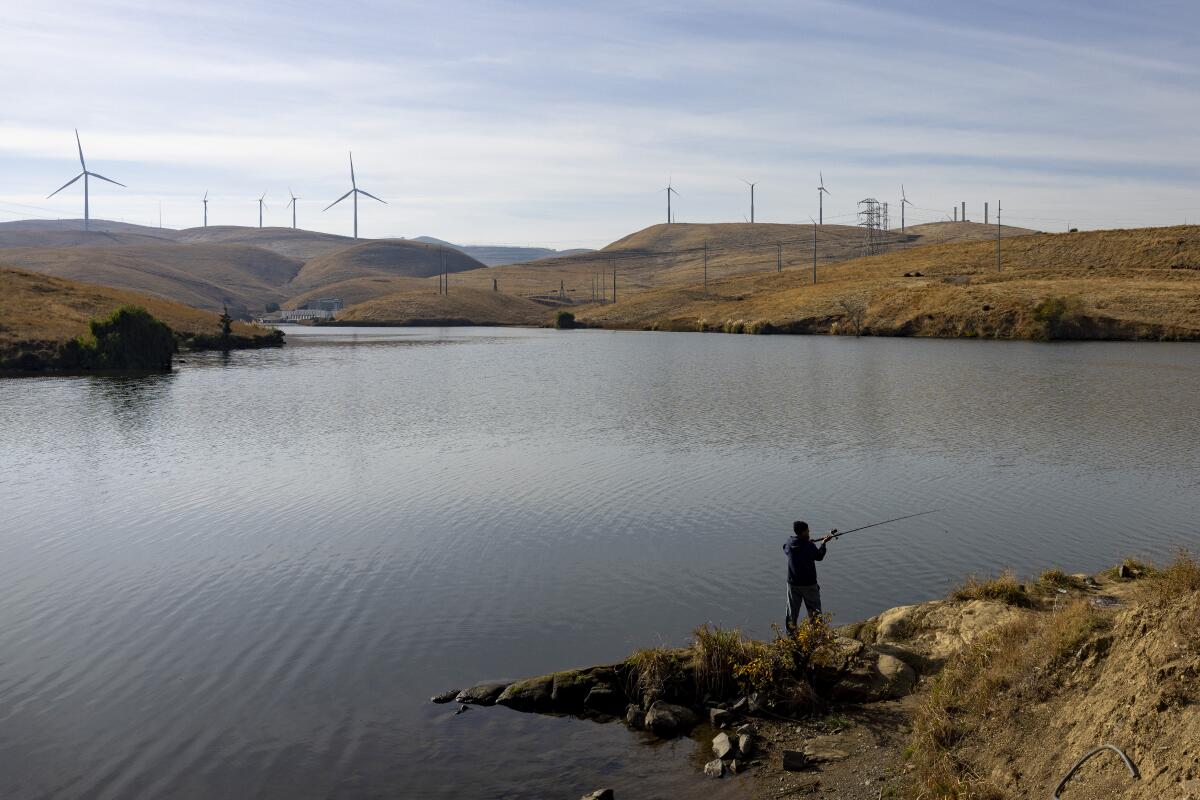
A fisherman casts into Bethany Reservoir in Byron, Calif.
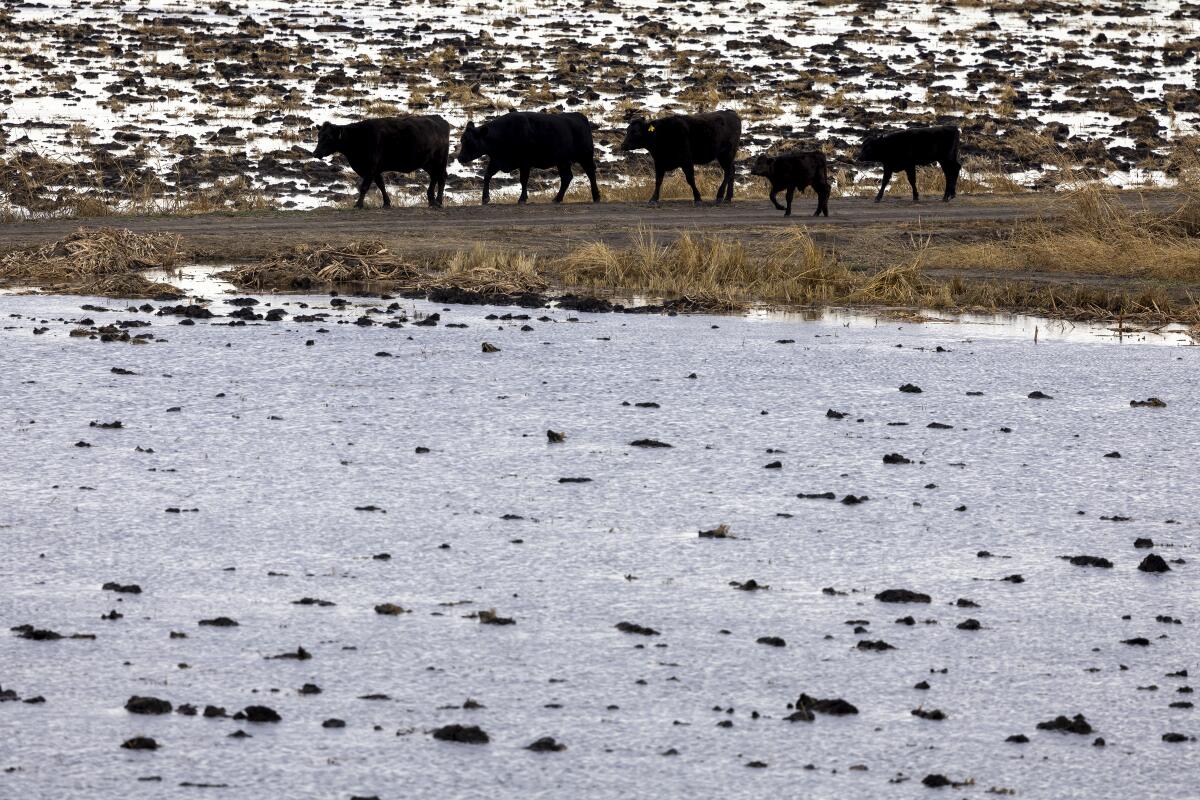
Cows walks along flooded rice fields adjacent to the San Joaquin River in Stockton. (Brian van der Brug / Los Angeles Times)
Today, the Delta Conveyance Project is a key component of Gov. Gavin Newsom’s strategy for a hotter, drier California, which predicts that the state may lose as much as 10% of its water supply by 2040.
Iterations of the project have been floating around since at least the 1980s, when Gov. Jerry Brown championed a so-called Peripheral Canal that would skirt water around the delta for use by the State Water Project — the vast network of canals, reservoirs and pipelines that delivers water from Northern California to farmlands and cities to the south.
The Peripheral Canal concept died at the ballot box in 1982, but the idea was later rekindled by Gov. Arnold Schwarzenegger and during Brown’s second administration in the 2010s, when it morphed from a canal to a set of twin tunnels known as the California Water Fix. It, too, failed to gain public support.
Newsom in 2022 officially downsized the concept from two tunnels to one, rebranding it, again, as the Delta Conveyance Project. In December, the DWR released its final environmental impact report and stamp of approval for the $16-billion project, moving it perhaps closer than ever to becoming a reality.
But whether the tunnel is ultimately built depends on gaining enough support among local water suppliers and the public. Opponents are also trying to block the project in the courts.
On a recent tour of the area, officials in Newsom’s administration said the new design is more efficient and economical than its predecessors and will have fewer environmental impacts.
The preferred plan would begin with two intake valves along the Sacramento River near the community of Hood, about 15 miles south of the capital. Both intakes would operate at a maximum of 3,000 cubic feet per second, pumping water through fine fish screens and into the tunnel for transport south.

Subscribers get exclusive access to this story
We’re offering L.A. Times subscribers special access to our best journalism. Thank you for your support.
Explore more Subscriber Exclusive content.
The 45-mile tunnel would run largely parallel to Interstate 5 before cutting west toward Bethany Reservoir, where it would connect with the California Aqueduct. It would have an internal diameter of about 36 feet and be buried at a depth of about 140 to 170 feet — where construction crews would bore through alluvium, sand, silt, clay and gravel beneath the soft soil and peat deposits along the marshy surface.
If completed, it would be one of the longest water tunnels in the world, and the state’s second-largest infrastructure project, behind the high-speed rail line. The project would be user funded, meaning participating state water contractors who receive the water would need to buy in. The $16-billion price tag hasn’t been updated since 2020 and will likely increase after another analysis this year, officials said.
Graham Bradner, executive director of the Delta Conveyance Design and Construction Authority, said he sees the tunnel as critical to California’s water future. Had it been completed in the winter of 2021-22, the state could have captured an additional 236,000 acre-feet of water, he said. (An acre-foot is about 326,000 gallons — or enough to supply up to three households for a year.)
Smaller than previous versions, the project is still huge, and is sure to be litigated by environmental groups and Sacramento-San Joaquin farmers.
The gain would have allowed the doubling of that year’s allocation to the 29 agencies that depend on the State Water Project, which together supply about 27 million residents, Bradner said. Instead, the 2022 allocation was a scant 5%, which triggered significant cuts and calls for conservation, including the strictest-ever water restrictions for people in and around Los Angeles.
In 2023, the tunnel would have helped capture an additional 228,000 acre-feet of water during January’s heavy storms alone, Bradner said. This year, it could have captured 481,000 acre-feet during the rain events of Jan. 1 through Feb. 22, or enough for nearly 5 million people for a year, state officials said. Such opportunities are expected to increase as climate change warms temperatures and delivers more of the state’s precipitation as rain instead of snow.
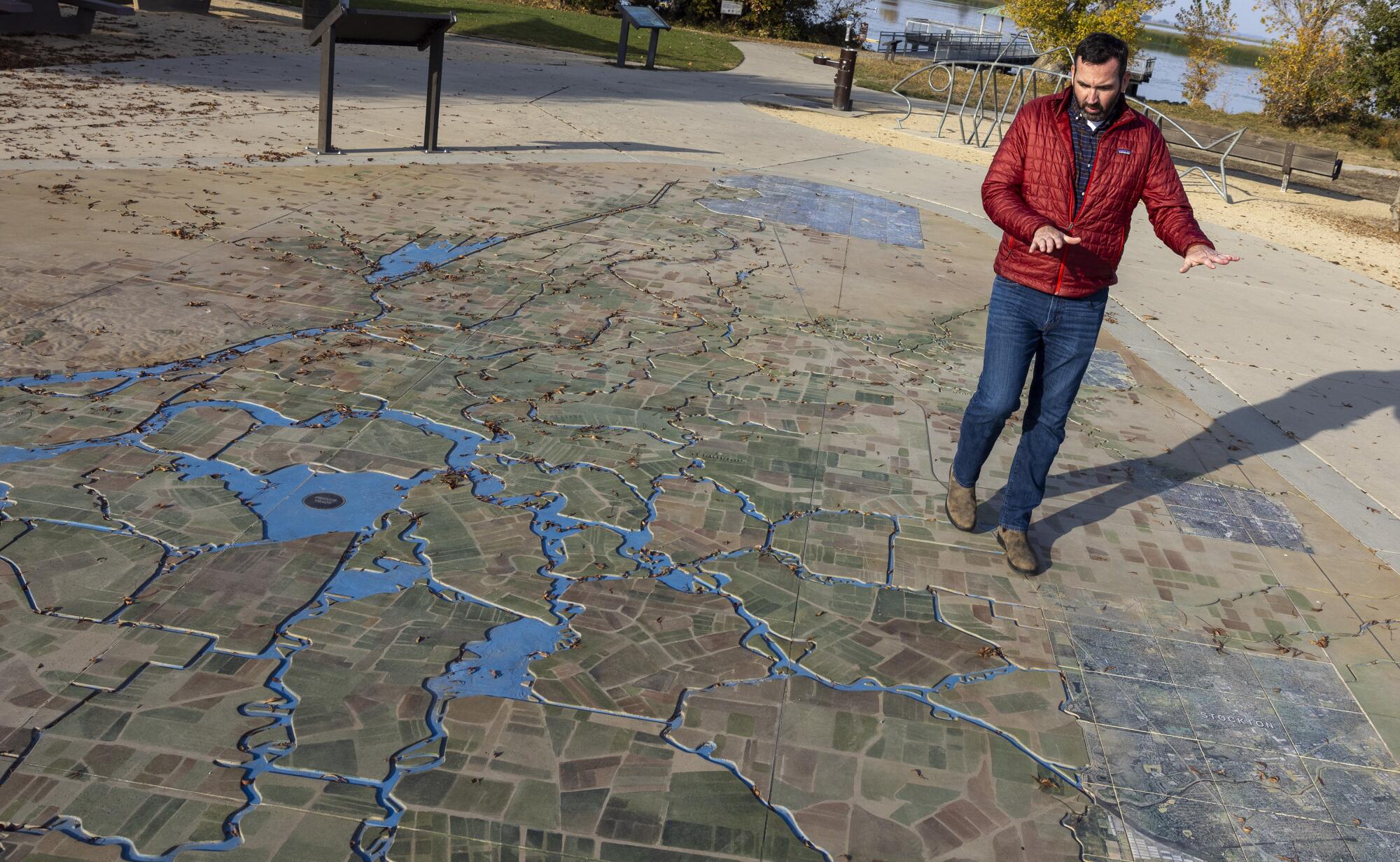
However, the tunnel isn’t only about capturing more water when it rains — it is also about securing the existing, aging system against cracks, breaks and breaches, Bradner said. There is a 72% chance that an earthquake of magnitude 6.7 or greater will strike the San Francisco Bay Area in the next two decades, according to the U.S. Geological Survey.
“There are mounting risks with the existing system, and the elements of the State Water Project in the delta don’t have resiliency embedded in them,” Bradner said. “A system is only as good as the weakest link, and in my mind, that’s the weakest link of the State Water Project.”
Indeed, there are more than a thousand miles of levees in the delta, and many are not in condition to withstand significant storm surges or shaking from an earthquake. During the January 2023 storms, nearly a dozen earthen embankments along the Cosumnes River, near Sacramento, breached, causing flooding that resulted in three deaths.
Bradner said the tunnel plan is inherently safer than surface levees. Not only is the project engineered to withstand significant shaking, its confinement underground would help protect it from amplification experienced on the surface during a temblor, he said, and “nearly eliminates its risk of liquefaction.”
When asked how confident he is that the tunnel will be built, Bradner said it’s “more of a hope than a confidence.” The project still requires numerous state and federal permits before it can advance.
“I think it’s incredibly important for the State Water Project,” he said. “I hope it gets built.”
A California water advocacy group is criticizing Gov. Gavin Newsom’s proposed Delta Conveyance Project, saying it would be a fiscal disaster.
But opponents say there are numerous issues with the plan, and contend that its multibillion-dollar price should instead go toward shoring up levees and restoring natural floodplains to reduce flood risks while changing water management to protect the estuary’s health.
“It is a lot easier, in a catastrophe, to fix a levee than a tunnel,” said Barrigan-Parrilla, of Restore the Delta.
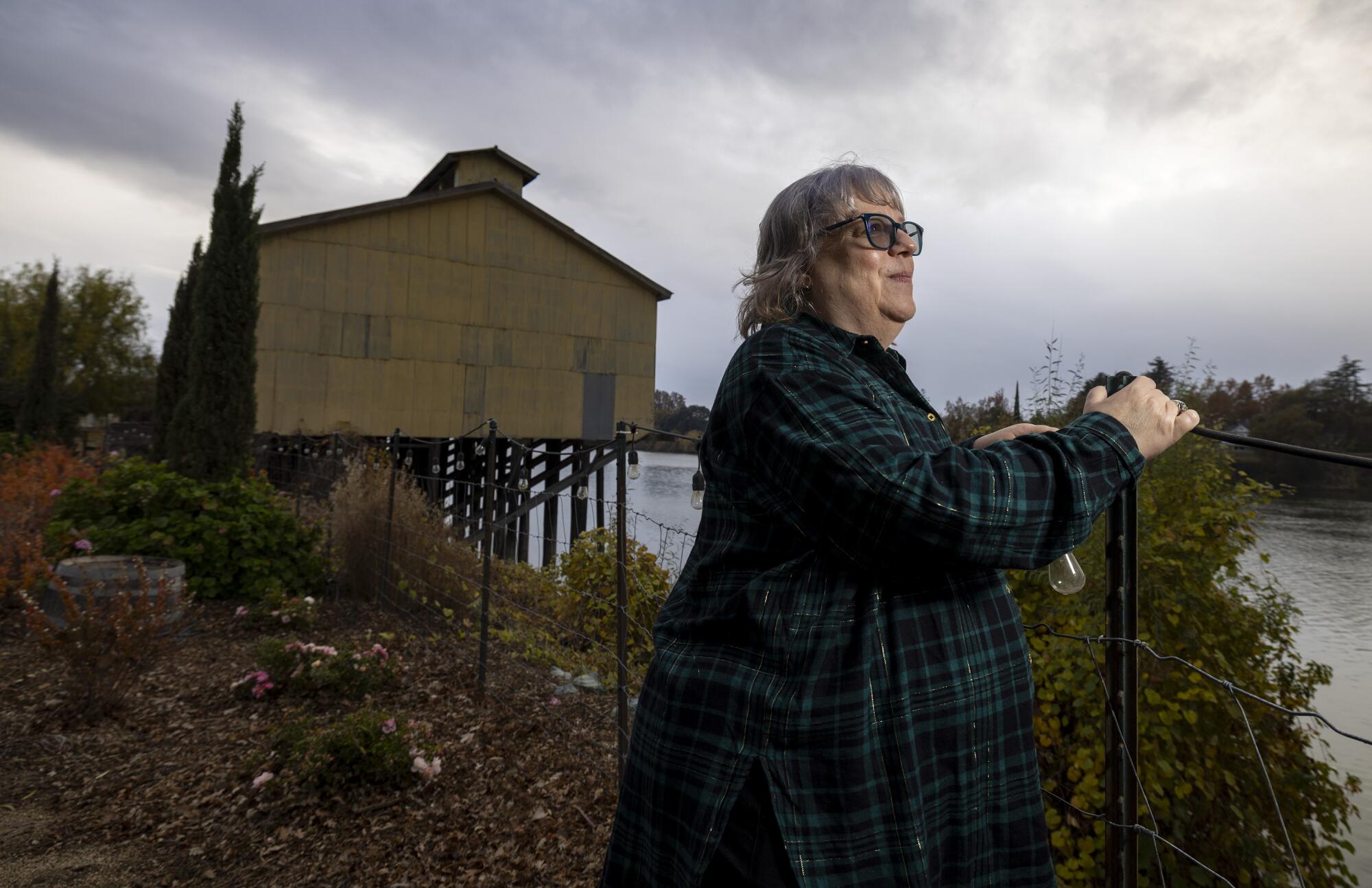
The delta’s problems start with how the water systems are currently operated, pumping out far too much water, she said.
“We understand that we have to share water because of where the population is in California, how our water systems were built. We do not have a problem with that,” Barrigan-Parrilla said. But she and others have been calling for water quality standards that would require allowing more water to flow through the delta for its ecological health.
“There is a body of science out there that shows that you can’t divert more than 25% of the fresh water from an estuary and have it survive. And we have been diverting 50% and 60% regularly now, and that is why the delta is dying,” she said.
She noted that the state has not yet completed an update to its Bay Delta Plan, which establishes water quality control measures and flow requirements in the watershed. The plan is supposed to be reviewed every three years but has not seen a major update since 1995. The state should finish that first before moving forward with its tunnel, she said.
What’s more, Barrigan-Parrilla argued, the project is “not built on our current climate reality.” She said officials lean too heavily on past climate patterns that are no longer applicable amid the state’s rapidly changing conditions. Many of the plan’s components were based on biological opinions issued during the Trump administration, which deprioritized protections for salmon and other threatened species, she said.
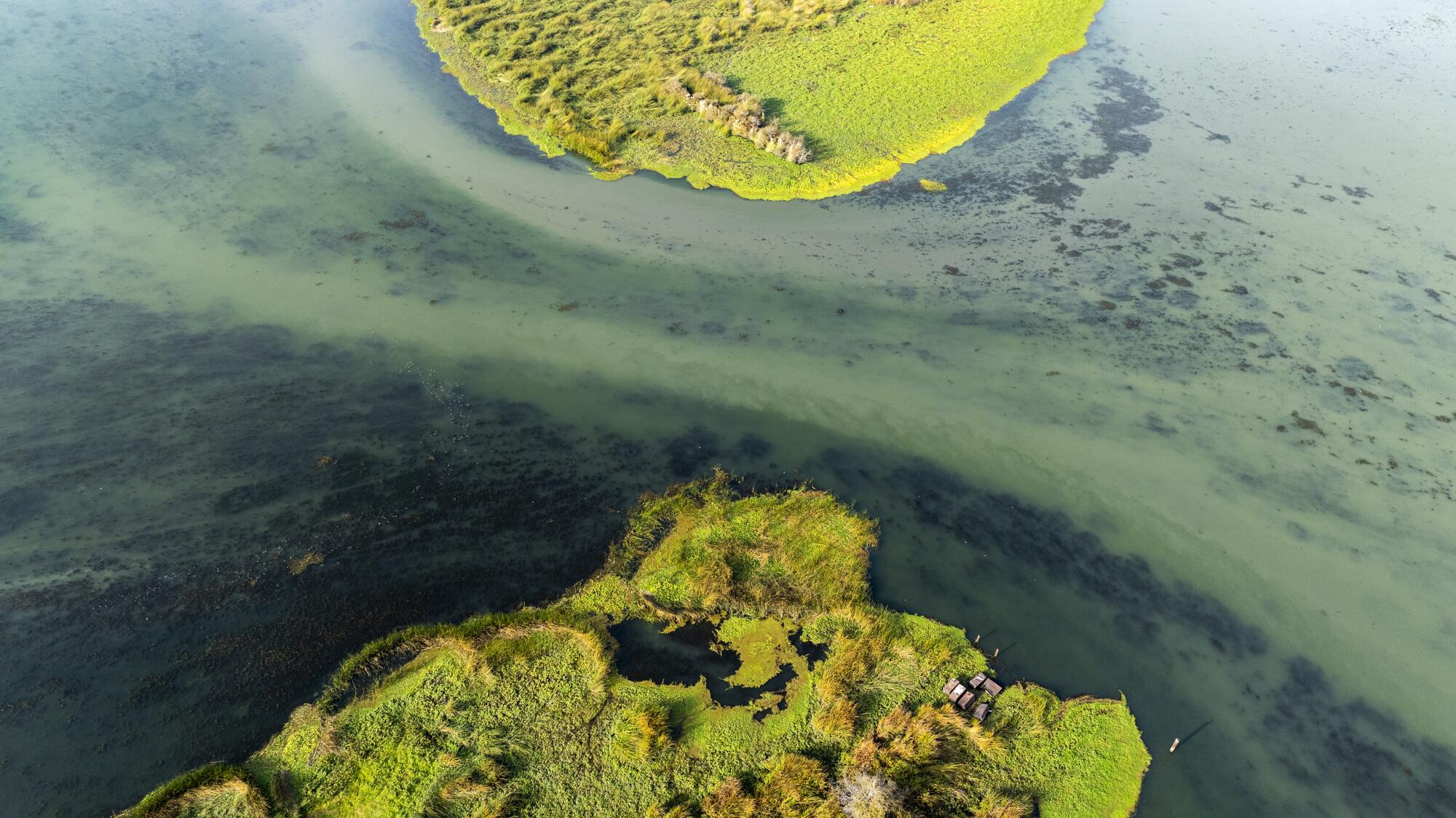
Her team emphasized that the project poses considerable ecological threats to the fragile delta, which has seen its size shrink and its wildlife suffer over the years. By taking more water from the delta that otherwise would run through it, the tunnel would cause even more damage, they say.
That includes more harmful algal blooms, which turn waterways bright green and produce toxins that can be dangerous to people and wildlife. The blooms are more likely to form in still, warm waters, said Spencer Fern, the group’s science program manager. That means any reduction in cold, fresh water running through the delta could worsen the blooms.
The Newsom administration is moving ahead with the tunnel project while also fast-tracking plans to build Sites Reservoir, which would divert water from the Sacramento River. Environmental groups have sued to challenge the reservoir project north of Sacramento, arguing that it would harm struggling fish populations and the delta’s ailing ecosystem.
The tunnel has also faced a number of legal challenges and setbacks in the weeks since its latest approval. In January, a California judge ruled that the DWR does not have the authority to issue revenue bonds for the project — a decision agency officials said they had anticipated and planned to appeal.
That same month, a group of environmental and tribal organizations — including Restore the Delta, San Francisco Baykeeper and the Shingle Springs Band of Miwok Indians — filed a lawsuit to stop the project, arguing that it violates the California Environmental Quality Act and that its environmental report fails to address potential harms to marginalized communities and endangered fish populations and wildlife.
A coalition of California tribes and environmental groups is calling for U.S. Environmental Protection Agency oversight of the state water board.
Barrigan-Parrilla spoke while driving on levee-top roads through the delta, passing rice fields, vineyards and waterways lined with vegetation. Signs proclaiming, “Save the Delta,” “Stop the Tunnel” and “No Tunnel” stood on lawns and roadways throughout the area.
Many signs were put up by residents who live in the disadvantaged communities that surround the delta, which already suffer from some of the worst air quality and water contamination issues in the state. The project would require an estimated 12 years of construction, which they say will worsen pollution and take thousands of acres of prime farmland out of production.
In fact, a recent state survey of residents in disadvantaged delta communities found considerable opposition to the tunnel, with 71% of respondents saying the project has no benefits. Ninety percent of respondents said they eat fish from the delta four or more times a week.
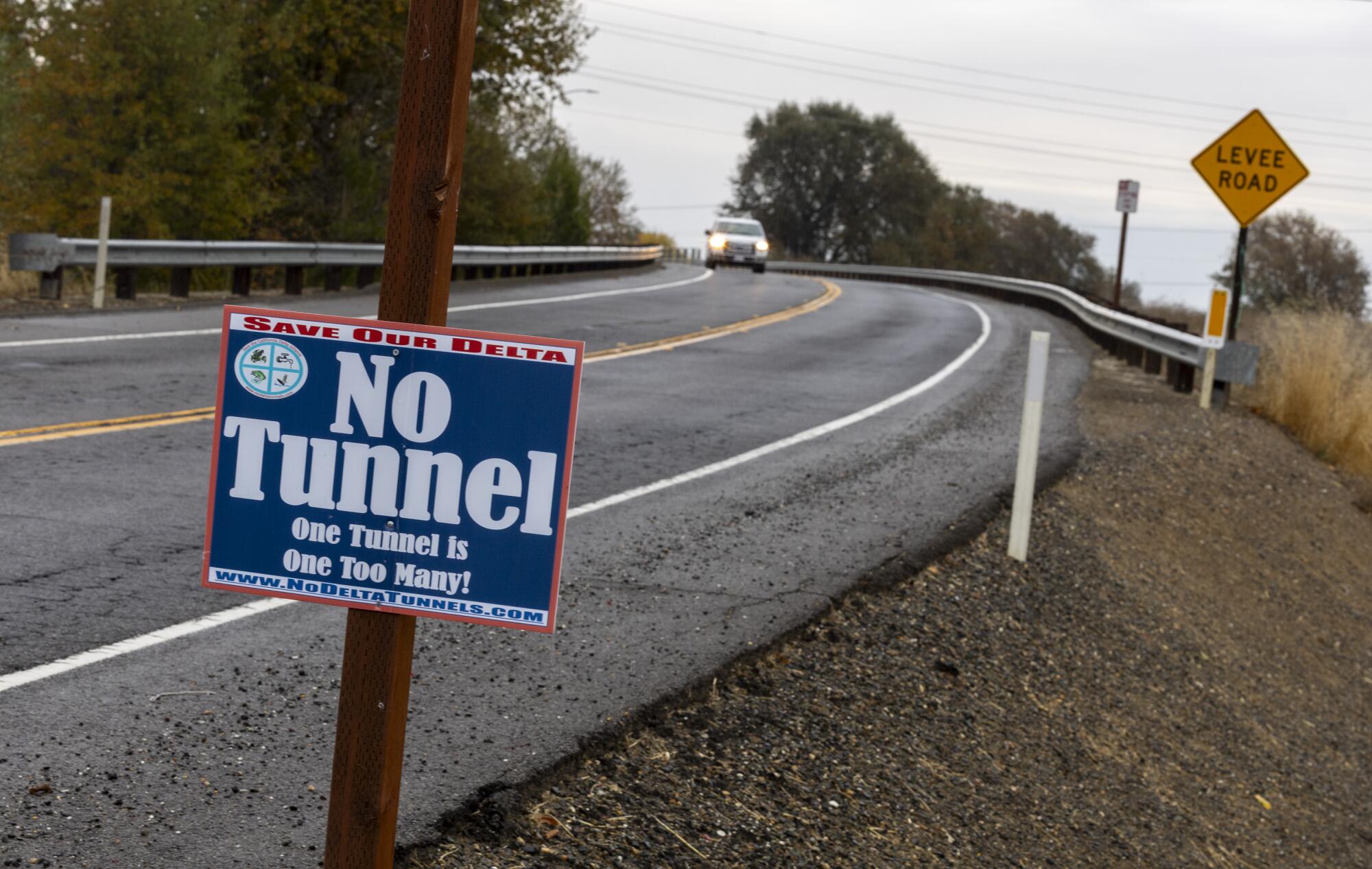
“The tunnel is like dropping a bomb on the north delta, and this area living with the fallout,” Barrigan-Parrilla said, referring to the southern delta region near Stockton. “If you take ... more fresh water out of the Sacramento side, our water quality is just going to deteriorate that much more.”
Threats to water quality, fish and wildlife are particularly relevant for Indigenous groups in the area who have long relied upon the region’s waterways, said Malissa Tayaba, vice chair of the Shingle Springs Band of Miwok Indians.
Subscribe Now
Catch up on the day with the 7 biggest L.A. Times stories in your inbox every weekday evening.
You may occasionally receive promotional content from the Los Angeles Times.
The tribe is part of a coalition that filed a Title VI civil rights complaint with the federal Environmental Protection Agency in 2022, alleging that the delta’s environmental decline, as well as the state’s oversight of water resources, was “rooted in white supremacy.” The coalition said those concerns were amplified in February when DWR submitted a petition to the State Water Resources Control Board to change water rights for implementation of the tunnel project.
The delta was once a thriving wetland that provided plants, animals, clothes, medicine, housing and other materials the tribe depended on, Tayaba said. Its already weakened state would be further injured by the tunnel, which she said would not only continue to deplete fish populations, but also run through numerous culturally significant areas, including a burial site near one of the intakes.
Though state officials said they have conducted outreach to the tribes as part of the tunnel’s planning process, Tayaba said the communications were terse and not meaningful — akin to “checking a box.”
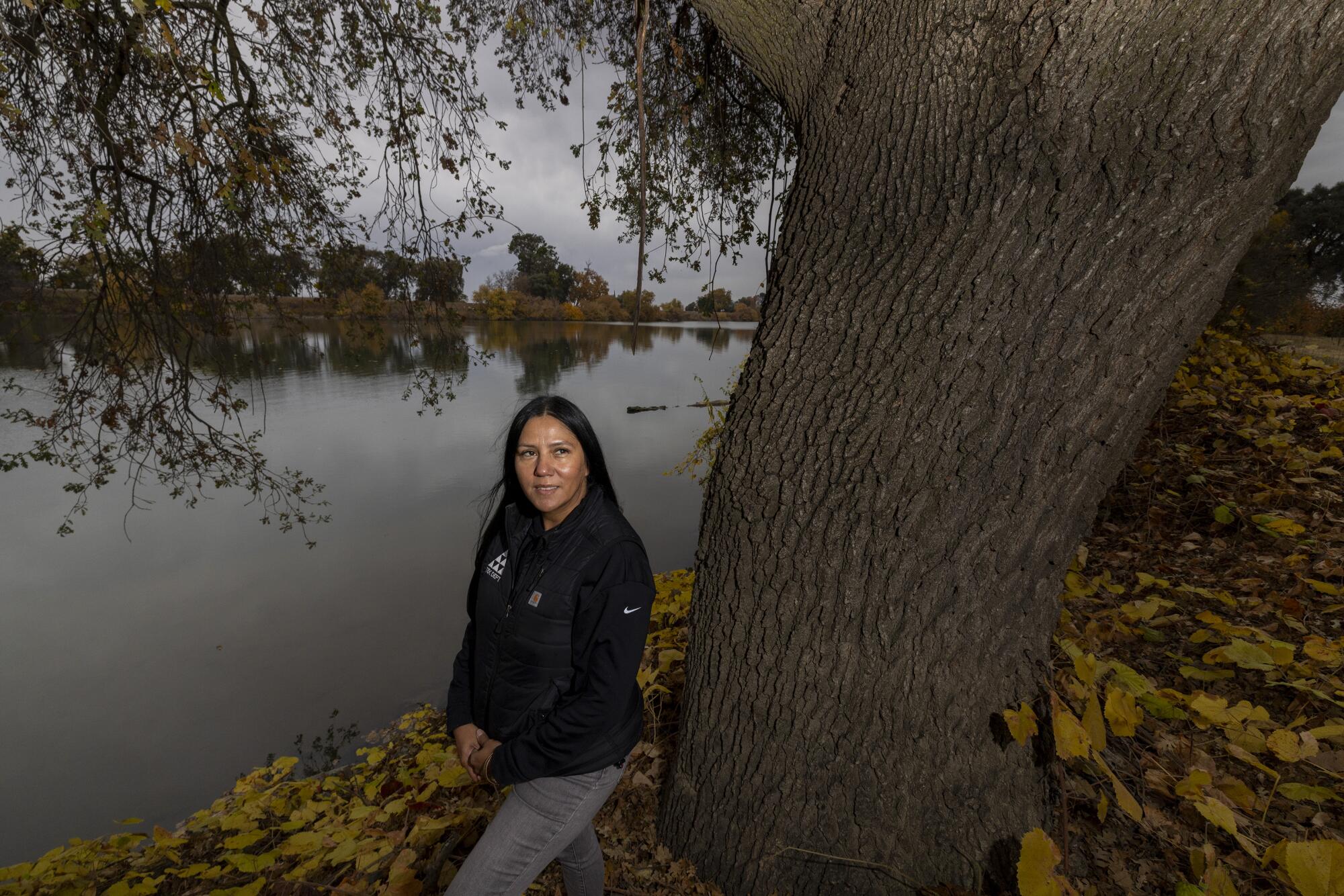
“We have been really working and trying to get our voices heard here on the waterways of the Sacramento River, because whatever happens — well, what has happened already — has affected us negatively,” Tayaba said. “But the Delta Conveyance will only make it worse.”
She added that having more water running in and out of the delta is essential to preserving the estuary’s bounty, such as willow and sedge plants used by the tribe for weaving.
Tribes and environmental groups have accused the Newsom administration of allowing excessive water diversions that have worsened declines in fish populations. Recent state surveys have found decreasing numbers of endangered delta smelt in the wild. And last year, commercial salmon fishing was shut down along the coast because populations declined dramatically.
“How many more species have to go extinct before something is changed?” Tayaba said. “How much more do we have to lose?”
Citing global warming, California Gov. Gavin Newsom has unveiled a new water strategy to conserve, capture, recycle and desalinate supplies.
Nemeth, the DWR director, said she has heard the angst and frustration of the project’s opponents, but that the latest iteration of the tunnel addresses many of those concerns. The DWR will have to comply with the state’s water quality control plans and other regulations that ensure its operation won’t injure other water users, she said.
At the same time, the intake capacity of 6,000 cubic feet per second is a small fraction of what can move through the watershed. During winter storms in 2023, the system saw an outflow of 150,000 cubic feet per second — more than twice the volume of the whole Colorado River, Nemeth said.
Officials have studied alternatives to the project “backward and forward” — including armoring existing levees, constructing new above-ground facilities and diverting more water from other areas — but none have proved better than the tunnel, Nemeth said. She added that she views it as modernization of the existing system, not as a wholesale new project.
“Even though it’s going to take us what feels like a long time to plan, permit, design and construct this facility, the value of it, by the time it is operational ... really increases over time given the intensity of climate change,” she said.
It’s one of several motivations for the project, Nemeth said, noting that the potential for a powerful storm or earthquake to breach one of the delta’s levees “keeps me up at night.” Such an event could foul the state’s supply of fresh water with an intrusion of salt water or cut off supplies for 27 million Southern Californians indefinitely, she said.
But climate change is quickly rising in the ranks of her fears as it drives worsening swings between extreme drought and extreme precipitation, also known as “climate whiplash.”
She pointed to the start of 2023 as an example of this effect, when more than 30 atmospheric rivers unleashed a torrent on California following the state’s driest three years on record.
“Climate is creating a system that is going to be much flashier into the future, and so we don’t have the capability — or the luxury, if you will — of having a system that is not competent at diverting water when it’s wet,” Nemeth said. “And the system that we have now is not competent enough to divert water when it’s really wet, and the risk of that to overall California water supplies is greater and greater as climate asserts itself.”
About 95% of the water that flowed into the Sacramento-San Joaquin River Delta in the first two weeks of January ended up in the Pacific Ocean. Here’s why.
Few know that risk better than Adel Hagekhalil, general manager of the Metropolitan Water District of Southern California — the largest water wholesaler in the nation, which supplies nearly half the state’s population.
The MWD is heavily reliant on the State Water Project for its supplies, and was so hamstrung by 2022’s low allocation that it issued unprecedented water restrictions for more than 6 million residents in coastal Southern California, including Los Angeles and parts of the Inland Empire. Those restrictions were only lifted following heavy rains in 2023.
That’s partly why the MWD has backed the tunnel project, including a $161-million investment toward its planning and environmental work in 2020. A few years before that, the agency also purchased four islands in the delta at a cost of $175 million in connection with the project, though a change in the tunnel’s route has now moved it away from the islands.
The MWD would be one of the largest beneficiaries of the tunnel, with an estimated 47% of its share of water, Hagekhalil said.
“To me, the future of water management is to find water when we have it, and move it into the system and store it, so when we do not have it, we’re not fighting over it,” he said.
The question of where to park the excess water also remains unanswered, and could require new reservoirs or other infrastructure. The MWD is working to complete a new water bank in the Antelope Valley that will allow it to store more supplies from the State Water Project in aquifers, and is looking for similar opportunities in other parts of the state.
“Southern California still depends on water from the delta,” Hagekhalil said. However, the tunnel is no silver bullet for the region’s water woes, he said.
“Yes, we can look at enhanced conveyance to capture water during wet years, but at the same time, we should be pushing hard on recycling and reuse and groundwater storage,” he said. And while the MWD has previously backed the project, officials plan to review an upcoming analysis of costs and benefits as they consider whether to invest more in the project. Hagekhalil said the agency’s officials also will assess potential impacts to the delta and its residents.
“A healthy, stable delta is critical not only to Metropolitan, not only to water supply, but also to the ecosystem, the communities and the farmers around the delta,” Hagekhalil said.
State officials also hoped to address some of those concerns, and touted the community benefits component of the project, which they say will help offset some adverse effects on the area’s residents and the environment. The benefits include a delta community fund for projects geared toward recreation, air quality, habitat conservation and other local priorities, among other efforts.
A new water storage facility in the desert will bank supplies underground for Southern California in an effort to help the region adapt to climate change.
Yet such promises can be hard to swallow for people who live in Stockton, Locke, Hood and other places in and around the delta.
“It will slowly kill the little towns, because no one is going to want to live here, no one is going to be able to work here, and no one is going to want to recreate here,” said Virginia Hemly Chhabra, a sixth-generation pear farmer in Courtland. “The place that is so very special to so many people would be forever altered, and there’s no practical way to cushion that.”
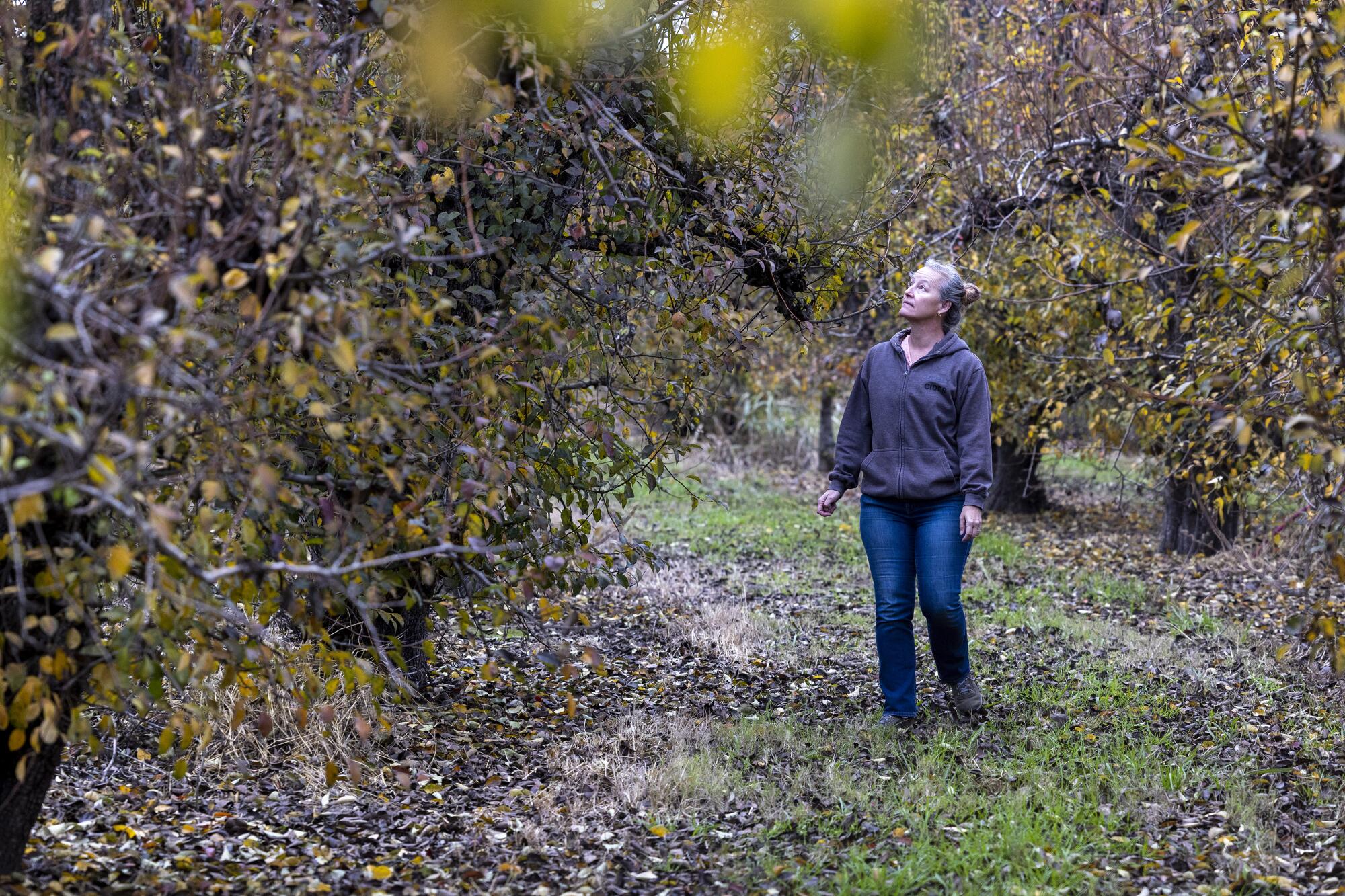
Construction on the project alone would cripple the Greene & Hemly farm — one of the few remaining pear packing houses in California — as it would cut through a state highway and block their driveway, Hemly Chhabra said. One of the tunnel’s proposed intake valves would be located next to her pear farm, about 200 yards from the front door of the Victorian home that has been in her family since the 1870s.
But even setting aside personal sacrifices, Hemly Chhabra said, she is convinced the tunnel would not deliver on what’s promised. She said she believes the project wouldn’t make available nearly as much water as state officials expect, and that construction would devastate the region and disrupt thousands of lives.
“I don’t think that it will provide the water supply reliability that the state needs. And at the cost of social, environmental and economic impacts that cannot be recovered from, there will be a very expensive — albeit very sexy — project that will not accomplish its stated goals,” Hemly Chhabra said.
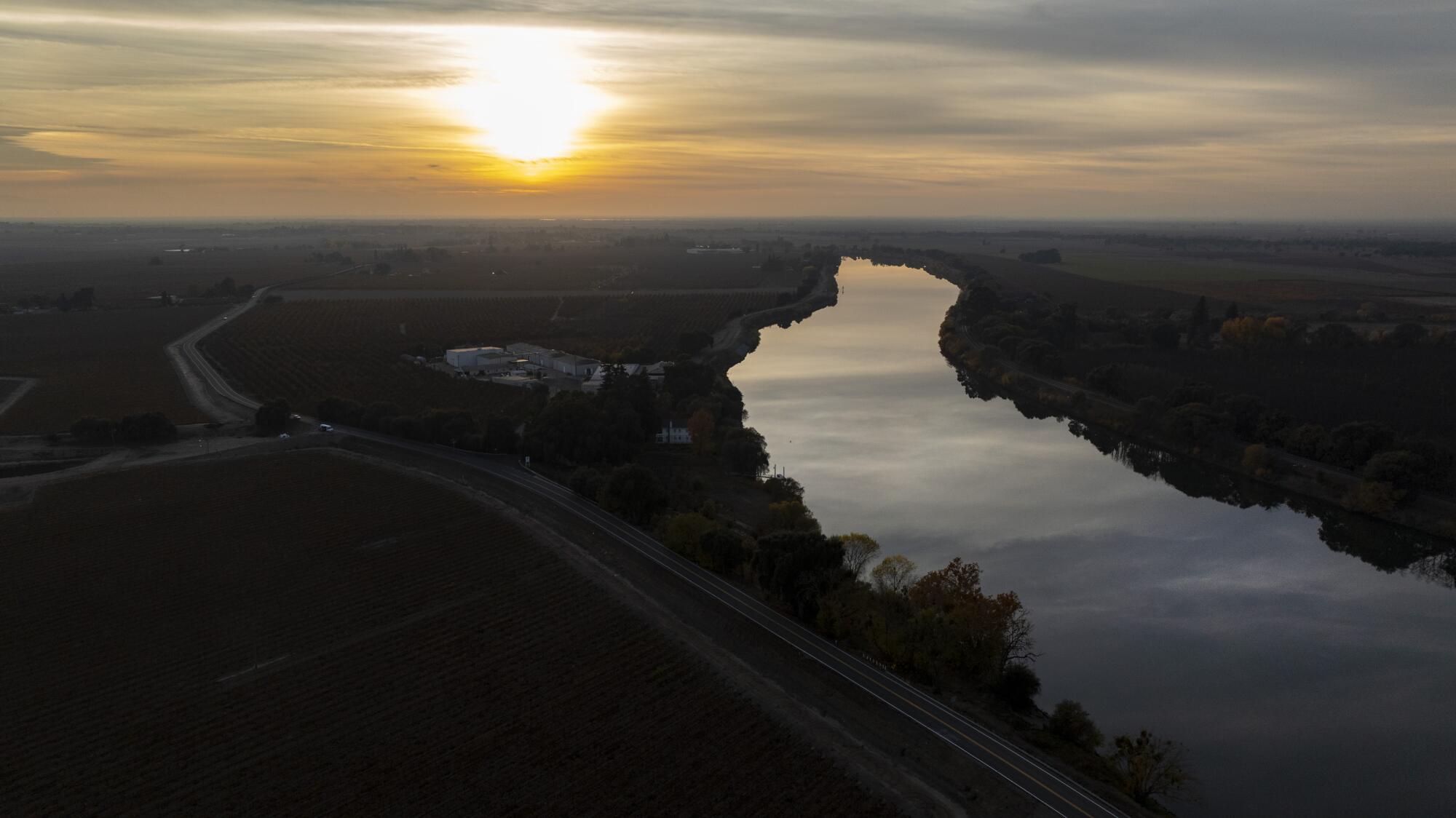
She and other locals are also concerned about the tunnel’s direct impacts on the area’s ecosystem, including the potential for reduced flows to affect the fish and birds that have long come to depend on the delta.
“There is no easy way to quantify it,” Hemly Chhabra said as she gazed over the slow-moving Sacramento River from the orchard beside her home. “Parts of it will be a very quick death, and parts of it will be a long, slow death of a thousand cuts. But it will forever change.”

